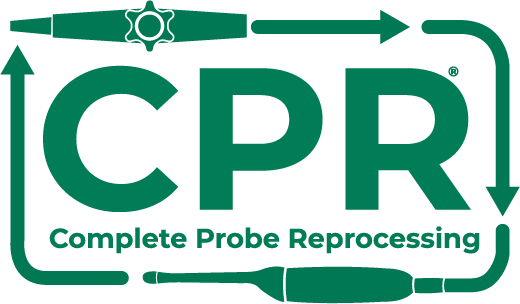Could Trade-Offs Affect Healthcare’s Ability to Provide Safe and Effective Patient Care?
kNOw Risk
In today's economy and the continued desire and challenge to find cost savings, many healthcare facilities are looking at trade-offs that may or may not have long term ramifications to the overall good and well-being of the institutions they serve and overall patient safety. It has been identified in many publications and by infection control specialist that the difference between a reusable high-level disinfectant and one that is single-use can lead to better outcomes for staff and patient. The reprocessing of semi-critical devices, as outlined in the Spalding Classification, requires these devices must be high-level disinfected between patient use. So, do you use a single-use disinfectant or take the chance that all the steps are followed when using a reusable high-level disinfectant? Is the savings of the trade-off worth the risk?
In a study published in the Journal of Clinical Microbiology, an interesting observation was made about reusable disinfectants. They are subject to issues of dilution and contamination when stressed repeatedly by multiple cycles.1 This study found a loss in concentration from approximately 2.3% to about 1.1% in the disinfectant after 4-6 cycles in an automated disinfector. Gradual increase in protein content over the 14-day test period also occurred, potentially contributing to the loss in disinfectant content. The efficacy of the disinfection toward particular microorganisms diminished as well as a function of time with only one of five passing the authors' minimal 3-log reduction criterion for the full 14- day period.
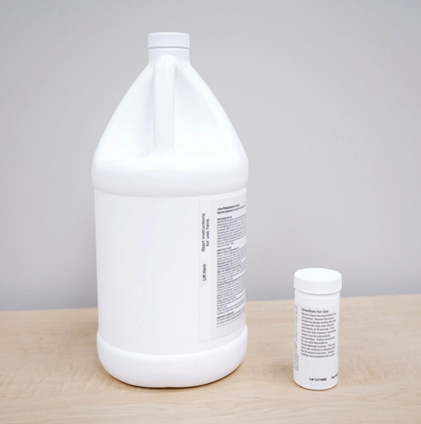
The concerns about reusable disinfectant dilution and contamination are expressed in the "Guideline for Use of High-Level Disinfectants and Sterilants for Reprocessing Flexible Gastrointestinal Endoscopes". 2
"The following factors result in a gradual reduction of the effectiveness of reusable high-level disinfectants/sterilants (Rutala et al., 2008; ASGE Standards of Practice Committee et al., 2008; AAMl, 2010):
- Decreased concentration because of challenging loads of microbes and organic matter
- Dilution by rinse water from endoscopes or items not sufficiently dried
- Aging of the chemical solution”
The need for monitoring the concentration of a reusable disinfectant before each use is cited in this document and is required by the FDA3 . This requirement was established to ensure that the Minimum Required Concentration (MRC) is met prior to disinfection. Typically, colorimetric indicator strips are employed to test for the MRC. These indicator strips require the end user to complete an initial Quality Control authentication prior to use and to be used within their expiration date. Operator training and the maintaining of logs are required for compliance to the manufacturers' IFU. The indicator test strips are specific to a particular manufacturer's disinfectant and cannot be used with a competitor's product, even if it is the same disinfectant chemistry. Operator training then becomes critical as there are notable differences in instructions for proper test strip use. For example, although both Cidex® CPA4 and Metricide‘” OPA Plus5 direct the operator to test for the MRC for each newly opened container of test strips for Quality Control purposes, the instructions for preparing the negative controls vary in volumes used to achieve the dilutions to the MRCs. Immersion times for these strips differ (exactly 1 second vs. exactly 2 seconds), methods for removal of excess disinfectant from the strip differ (capillary action by a paper towel with no shaking vs. shaking) and color development times differ (exactly 90 seconds vs. exactly 60 seconds), respectively. The operator must also be able to properly interpret the strip color changes and be able to discern whether striations of blue upon purple or yellow upon magenta have occurred, which indicate that their respective disinfectant is below the MRC and must be discarded. Results then need to be logged and maintained. Adding additional reusable high-level disinfectants only increases the variables that healthcare staff must be trained on and maintain competency.
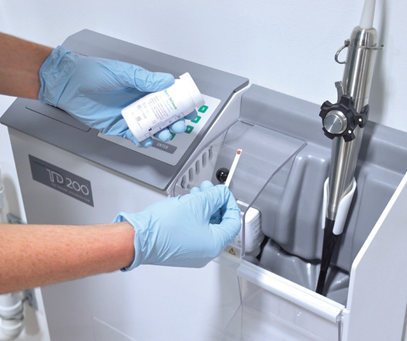
One final administrative issue with using test strips involves maintaining an adequate, on-hand supply, particularly when multiple manufacturers' products are used. Test strips are supplied in different quantities, depending on the particular disinfectant. The necessary Quality Control process cited earlier consumes six test strips alone (three for the positive and three for the negative controls) for both the Cidex CPA and the Metricide OPA, reducing the number of disinfection tests obtained from a single container of strips.
CS Medical's TD-5 and TD-8 provide value in that the correct volume at an effective concentration is delivered each time. There is no wasted disinfectant and no daily monitoring for MRC. The spent disinfectant and subsequent rinses are automatically discharged. The operator encounters no significant dermal or respiratory exposure to these high-level disinfectants when used as directed in the TEEClean or TD 100.
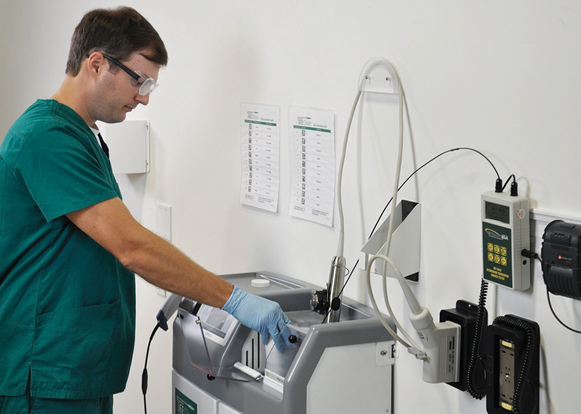
Reusable disinfectants that test below the MRC, exceed the 14-day reuse period or reach their expiration date during the reuse period, must be replaced. Significant quantities, as high as multiple gallons, would then have to be neutralized or disposed of, adding potential operator exposure, as well as time and cost to the process.
In an idealized scenario that avoids consideration of the effects of bioburden contamination and disinfectant dilution below the MRC, claims projecting as many as 250 disinfection cycles per single OPA gallon can be found for certain dual probe-disinfecting automated reprocessors. These claims are premised on simultaneous disinfection of two TEE probes amounting to 9 disinfection cycles per day for 14 continuous days. Ignoring the logistical question of whether two probes would be simultaneously and consistently available for disinfection, the main issue of maintaining the MRC of reusable OPA disinfectants is called into question. A study comparing two manufacturers' 14-day reusable OPA products, for example, found that one failed the MRC indicator strip test after 42 reuse cycles, essentially at day 8 after a two-day idle period from day 6. A total of seven disinfections of two probes in a commercial AER were conducted each day with bioburden added at the beginning of each test day to provide a real-world challenge. Although the AER basin volume was not reported, the minimum volume used in calculations was four gallons. These results underscore the potential for a reusable OPA solution to fail to meet the MRC within the reuse period even in a volume substantially greater than one gallon.
The ability of medical devices to consistently provide high-level disinfection is predicated on its engineering and is another indicator of value. The CS Medical TEEClean automated cleaner disinfector and the TD 100 automated disinfector have years of successful service history for TEE probe disinfections. The TEEClean and TD 100 automatically warms the approved high-level disinfectant, TD-5 or TD-8, to its validated in-use temperature of 38-40°C within minutes for a 5-minute disinfection cycle followed by 5 consecutive rinses. There is no need to pre- warm the high-level disinfectant in a water bath prior to use, or rely on convection currents to eventually equalize the temperature throughout a plastic gallon disinfectant bottle when heated at its bottom surface by a warming plate. Those techniques are used in some automated disinfectors that employ a reusable disinfectant. The TEEClean and TD 100, on the other hand, recirculates its single-use disinfectant through a heating element and monitors its temperature at separate flow points in the device to ensure a consistent 38-40°C temperature during the disinfection cycle. The disinfectant circulates around the TEE probe in a continuous flow and enables unutilized disinfectant to come into contact with microorganisms on the probe surface.

This process contrasts with some devices that employ a single fill of disinfectant into a reservoir where it remains static at the probe surface interface during the disinfection phase, until returned to its reuse bottle. There is no further fluid motion to completely utilize the disinfectant. Likewise, rinse cycles in certain reprocessors follow a similar fill and drain process, lacking the circulation that assures removal of disinfectant residues from the probe and reprocessor surfaces, as has been engineered into the TEEClean and TD 100.
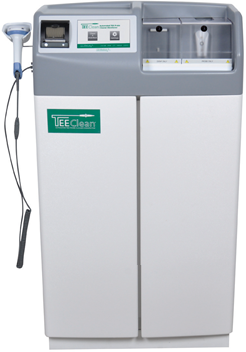
Conclusion
These designed attributes are what differentiates the TEEClean and TD 100 from some reprocessors that employ reusable disinfectants. The technology to maintain a well-controlled, validated disinfectant temperature range with a single use disinfectant, that does not introduce all the potential problems when using a test strip is clearly superior to reliance on a continuously heated disinfectant bottle, wherein transfer of a small volume of heated, reusable disinfectant is pumped through the device and into a disinfection chamber that could result in temperature loss and disinfection failure. Recirculation of single-use TD-5 or TD-8 through the TEEClean or TD 100 provides for full utilization of the disinfectant on the TEE probe surfaces, and recirculating rinse waters assure disinfectant removal.
So, when looking at the tradeoff of single use compared to reuse chemistry for high-level disinfection, make sure to account for the risks we have outlined that is related to operator training, storage of supplies, and having the right administrative processes checks in place to ensure the correct MRC is present every high-level disinfection cycle that is completed. Is the trade-off worth the risk? This is a decision that must be evaluated by each individual institution and not one that should be taken lightly.
References:
1. Mbithi,J.N., Springthorpe, V.S, Sattar, S.A., Pacquette, M., "Batericidal, Virucidal, and
Mycobatericidal Activities of Reused
Alkaline Glutaraldehyde in an Endoscopy Unit",J. Clinical Microbiology, Nov. 1993, p.
2988-2995.
2. Society of Gastroenterology Nurses and Associates, Inc. (SGNA), © 2013. Section F,
"Determining Minimum Effective
Concentration (MEC)".
3. "Guidance for Industry and FDA Reviewers: Content and Format of Premarket Notification [51
0(k)] Submissions for
Liquid Chemical Sterilants/High-Level Disinfectants", US. Food & Drug Administration,Jan. 3,
2003.
4. Cidex OPA Solution Test Strips IFU, LC-20392-003 Rev. F. 9/9/04.
5. Download PDF - Guide to using Metricide
6. Bruckner, N., Ph. D. "Comparison of Metricide OPA Plus’M Solution and Cidex® OPA Solution
Use
Properties", Oct. 2007,
online at Metricide White Paper
